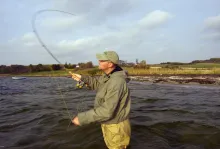The taper is the most single important aspect of a leader. This article tells you the principles behind leader design
Leader Design Principles
The leader absorbs and disburses the energy created by the cast. It is the goal to control energy absorption as best as possible. Given that, we can decipher that the taper is the most single important aspect of a leader. A taper that is too short or stiff will snap your fly over during the presentation and a taper that is too long or supple will "hinge" and not turn over at all. Additionally, a leader that turns over nicely on a short cast, may be too supple to turn over on a long cast. As you can see, there are many things to consider when designing a leader. This article will not go too deep into the theory of leader design, but will consider the following principle rules-of-thumb when designing your own leader tapers:
- Leaders don't increase the amount of energy from the cast, thus there is no need to use leader material that is capable of transferring more energy than the flyline can develop.
- 9 foot leaders accommodate 80% of fly fishing situations.
- 4X or 5X tippets accommodate 80% of all freshwater fishing demands.
- Leader length equals rod length.
- Extreme Length: leader length equal to 1.5 the length of the rod.
- Start with the Ritz 60/20/20 rule and modify from there.
- Butt diameters should be roughly between 60% and 75% of the diameter of the fly line ( 0.017" - 0.022" ). 2/3rds is a good rule.
- The butt stiffness should approximate the stiffness of your fly line.
- Exceeding more than 0.002"-0.003 difference in material diameters between each section is a good rule-of-thumb. However, it is quite acceptable to reduce your leaders by 60% of the preceding leader section. Think of it this way: If it is OK for your leader butt to be 60% of the diameter of your fly line, it's certainly OK for each of your leader segments to follow suit!
- Line Clarity = personal choice.
- Abrasion resistance = the least amount needed as typically abrasion-resistant materials are less supple.
- Use blood knots for the butt and taper.
- Use a surgeon's knot for combining tippet sections.
- Design rapid tapers and long tippets where they transfer casting energy more quickly and smoothly.
- Smaller diameter or softer materials are less efficient at energy transfer than larger diameter or stiffer materials.
- The shorter the leader section, the more casting energy is carried forward.
- More casting speed is required for long and light leaders.
- Slow casters should use short tapers, fast casters should use longer tapers.
- Typical freshwater shock tippets are 10"-12" of 25-30 lb mono.
- Fluorocarbon is much more transparent than nylon and copolymer leader material.
- Fluorocarbon is not as strong as nylon and copolymer leader material.
- Fluorocarbon material is more dense than water and will sink. It's not the best for dry fly leader tippets unless it is greased, and the grease will decrease the stealth by making the leader more visible.
- Log in to post comments







